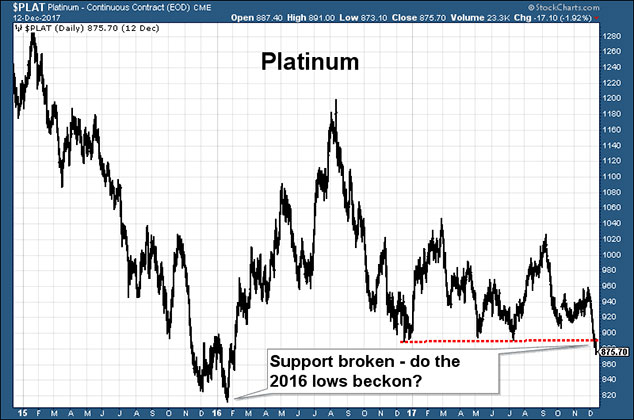
What with bitcoin, oil and sterling, you might have noticed your author is on a bit of a winning streak at the moment.
Beware arrogance creeping in! Mistakes follow. Mr Market – or is it Mrs? – has a habit of slapping down the arrogant with a big and resounding wet fish to bring them back to earth.
So today, to banish any hubris that might be attempting to make its way into the Frisby pysche, we focus on an investment that hasn’t been working.
Platinum…
Platinum “should” be worth more than it is (or at least, that’s the theory)
We got on the platinum bandwagon earlier in the year, in February. The price, from memory, was somewhere around $950 an ounce, maybe a little less. The plan was sell gold, buy platinum.
The idea behind the trade was pretty straightforward: platinum is cheap. It is one of the few things in this age of distorted pricing that is.
Platinum “should” be more expensive than gold. It is rarer; people crave it more; human beings see it as more valuable – platinum record sales or credit cards are considered “better” than gold. Indeed the historical and long-term average is that platinum is about 1.25 times the price of gold.
Yet it’s currently the other way around.
Gold is currently sitting around $1,250 per ounce, while platinum is a rather woeful $875. Our investment is some 10% or more underwater. We’re not drowning yet, but we are irritated. Other assets are rising in price. How much better would our life be if we’d put our money there?
1.25 times the price of gold is $1,560. That’s what platinum “should” be – 80% higher than where we are today.
For goodness sake, even palladium – currently $1,015 – is dearer than platinum. When did you ever hear of a record “going palladium”? What braggadocio ever attempted to impress the ladies with his palladium credit card?
Then there’s the fact that platinum is trading at, or even slightly below (depending on whose calculations you use) its cost of production. The current price of mining platinum is not going to get significantly cheaper. Excesses have, mostly, already been stripped away in the post-2011 mining recession. New platinum discoveries are few and far between.
The physical market is in deficit. Supply does not meet demand. Only recycling props it all up – and supply of scrap platinum is falling.
But these arguments have been circulating around around platinum ever since I first looked at it some 15 years ago. Sometimes they seem to matter, mostly they don’t. What matters more is sentiment. And at the moment the world could not be less interested.
Nobody gives a monkeys. About the only thing people care about less is silver. But neither can go to zero. They are precious metals: they may be out of fashion, but their time will come again.
It’s the bizarre times we live in. People care more about digital assets than they do about physical ones they can touch, hold and enjoy. Whether it’s beautiful Wedgewood china or elegant brown Georgian furniture – nobody cares. It’s just clutter. Give me the cloud!
Well, the value investor ignores what the rest is doing. He goes against the crowd. He bravely holds platinum, while the world scrambles to buy the Nasdaq.
A pox on your bitcoin, he says, I have my shiny platinum bar. Nerds can’t mine that!
So what’s next for platinum? Unfortunately it doesn’t look good for now
Here’s a three-year chart. You can see there was some support just below $900, where I have drawn the red dotted line, but that has now been broken.
You can’t help looking at that and thinking that the January 2016 low of around $810 is beckoning. The trend is down, I’m afraid. Aside from a momentary blip during the crash of 2008, the 2016 low was the cheapest platinum had been since 2003.
Given all the money creation that’s gone on since then, that would be “too cheap” if there is such a thing (which there isn’t).
On the plus side, platinum, unlike a company, cannot go to zero. So the declines have to stop somewhere.
One major problem platinum has, from a perception point of view, is the diesel scandal of a few years back. Diesel engines, we learned, are not as clean or green as we had been led to believe they were. The figures were being fiddled. And so demand for diesel engines has declined. Platinum’s main use was in catalytic converters, and thus platinum demand and projected future demand fell.
I’m not worried unduly about this. Something will happen – though goodness knows what – to trigger a change in perception of platinum.
They say a long-term trade is a short-term trade that went wrong. We declared when we went long platinum last winter that this was “a trade of the lustrum”, a lustrum being a five-year period.
We’re almost a year in and it’s not working out. We’re down a few percent. In the short-term, I have to say it looks like it is going lower. But human beings are fickle. What today is ignored, tomorrow is the must-have accessory for any portfolio. Fashions change. Markets are cyclical. Platinum’s time will come again.
Just not yet.